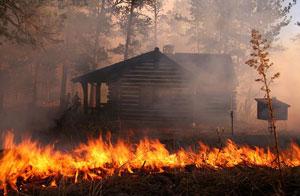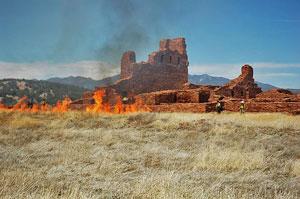Among the functions performed by the National Park Service, few can top "fire management" in terms of costs, public safety, and impacts on both park and adjacent property and activities. That said, you may wish to take advantage of the opportunity to review and comment on the agency's new Wildland Fire Strategic Plan: 2014-2019.
It's a document which offers some candid and realistic observations about the challenges faced by public agency fire managers in today's world.
The announcement about the public comment period, which ends on January 15, 2014, sums up the very broad audience that could be impacted by the plan: anyone who lives, works or plays in or near a National Park Service area which has the potential to be affected by wildland fire activity.
NPS Areas Include 53 Million of Acres of "Burnable Vegetation."
That definition covers a lot of people and places, so you might wonder just how much land is potentially covered by the fire management plan. According to the NPS Fire and Aviation Management Division, the agency "manages 401 parks and more than 84 million acres of land throughout the entire United States and its territories, from Maine to Guam. Of the over 84 million acres of land, 53 million acres have burnable vegetation."
The term "burnable vegetation" may sound a bit strange ("What other kind is there?" you might ask), but that's simply a commonly-used term in fire management circles to describe areas that are potentially at risk from wildland fires.
Some of that "burnable vegetation" is found in NPS areas that might surprise you, such as urban areas like Gateway National Recreation Area in and around New York City and desert locales like Death Valley National Park. Fire management activities for those areas are covered by the new plan, along with parks we more commonly associate with wildland fires, such as Yosemite and Yellowstone national parks.
This Draft Plan is a Quick Read
Unlike some of the NPS documents we bring to your attention on the Traveler, this draft of the Wildland Fire Strategic Plan can be easily read in just a few minutes; the Word document runs to only a dozen pages. As the title implies, this is a "big picture" plan, so don't expect to find detailed descriptions of actions to be taken in individual parks or situations.
This plan is a response, at least in part, to an intergovernmental "National Cohesive Wildland Fire Management Strategy," which you'll find discussed at this link and summarized on page two of the draft plan. The draft offers a Mission Statement: "The National Park Service Fire Management Program is dedicated to protecting lives, property and resources while restoring and maintaining healthy ecosystems" and two goals: "Protect Communities and Assets" and "Conserve Natural Resources."

Protection of structures will continue to be a high priority under the new plan. NPS Photo by Jon Freeman.
That language may sound pretty standard, so is this plan just a paper exercise with "more of the same," or does it suggest any shifts from past practices?
Here are a few excerpts that include some candid and realistic observations:
"Responding to and managing wildland fire on National Park Service lands in today's environment requires a change from the traditional approach previously employed by the Service and its partner agencies."
Plan Includes Trends and Predictions for NPS Fire Management
Included in a discussion of trends that are expected to affect the NPS wildland fire mission and program focus over the next five years are the following:
"Tightening federal budgets will reduce staffing levels and force organizational adjustments."
"Environmental, economic, political and social conditions will continue to limit the ability to achieve ecologic restoration goals in many locations. There are many challenges in achieving our fire management goals. Some are budgetary but many are not. We need to understand the challenges and be creative in overcoming them where possible, and pragmatic in understanding where they create true limitations."
Fluctuating Funding Poses Challenges
The plan acknowledges challenges caused by uncertainties in funding from year to year, along with changing public and political attitudes.
"Funding for managing fuels from wildland fire appropriations will continue to fluctuate. We'll need to apply our limited resources to the highest priority areas and those treatments that can achieve multiple objectives. We must be creative in seeking funding from alternative sources for treatments aimed primarily at resource management objectives."

Prescribed burning can help protect valuable cultural resources, such as these at Salinas Pueblo Missions National Monument, from being destroyed by unplanned fires. NPS Photo by Derek Toms.
"Public and political expectations for restoring and maintaining ecological landscapes are increasing in ways that are often inconsistent with current scientific knowledge. We must become better at telling our story, and setting realistic expectations both within the NPS and for our stakeholders."
"The Road Ahead"
A section titled "The Road Ahead" also offers some refreshingly frank observations:
"We have too often defined our mission objectives and priorities based upon budget availability, with an eye on continuing those actions that we have undertaken. It is likely that this lens has inhibited us from seeing some of the changes that now have a real effect on our capabilities and achievements."
"Determining what is truly needed to conduct our mission must be the primary driving force for all components of our work; the mission requirements set the frame for our allocation of resources and management strategies."
"Over the years, we have experienced changes in funding that, for a variety of reasons, have resulted in uneven growth and contraction throughout our organization. These cyclical and uneven fluctuations in funding and changes in the magnitude of fire seasons can often distort how we perceive the scope of our mission."
A "Complex and Indeterminate Environment"
The plan also points out that changes in both the natural and human "environment" pose some new challenges for fire managers: "... the environment in which we work continues to become more complex and indeterminate. Politics, economics, changing societal values toward public lands, long-term climate projections, air quality, ecological concerns, and a host of other factors, increasingly influence how we manage our lands and parks, especially near the WUI [Wildland Urban Interface]. Many of these factors inhibit the use of traditional methods of land management. Many of them press the very definition of what it means to be a good steward."
A section titled "Enhancing Our Culture" notes that the suggested approach "... also requires leadership to provide clear direction, to delegate and entrust decision-making to the lowest practical levels. Maximize efficiencies, reassess what is feasible to accomplish, prioritize, and at times say no to doing more with less. This necessarily requires holding ourselves accountable to understand and deliver an accurate picture of our mission, the intent of our actions, and our values."
Here's How to Get a Copy of the Plan
What does the plan envision as priorities for NPS fire management in the next few years? Beginning on page seven, you find a list and brief discussion of "Objectives," "Priorities for the Next 5 Years" and "Fire Management Values." If you'd like to read or download a copy of the NPS' Wildland Fire Strategic Plan: 2014-2019, you'll find a link here.
Comments can be submitted on-line through January 15, 2014 via this webpage. Prefer to send your comments via a letter and snail mail? You can do so to the following address, although it would be helpful if you'd first print and include a brief "cover" form found at this link.The postal mailing address is: National Interagency Fire Center, National Park Service, Attention: Richard (Dick) Bahr, 3833 South Development Avenue, Boise, Idaho 83705-5354.
According to the planning website, "After the comment period closes, all suggestions will be reviewed and discussed by the task group before a final plan is developed for review and approval."
That said, if you have major concerns or suggestions about this plan, now's the best time to have them considered.




Add comment